That’s the Spirit!
 I’m no stranger to risk-taking—I have skydived from 4,000 metres high and gone bungee jumping. I frequently dive with sharks, and I even fell in love and got married. When adventure beckons, I brace myself, gear up and get going. Nevertheless, the concept of canyoning or canyoneering was foreign and a little bit scary for me.
I’m no stranger to risk-taking—I have skydived from 4,000 metres high and gone bungee jumping. I frequently dive with sharks, and I even fell in love and got married. When adventure beckons, I brace myself, gear up and get going. Nevertheless, the concept of canyoning or canyoneering was foreign and a little bit scary for me.
Canyoning is an adventure sport that is rapidly gaining popularity worldwide. It involves the uncharted territory of specialised equipment, brain-boggling technicalities and challenging courses. But at the same time, it is also a combination of fun and thrilling outdoor activities such as trekking, scrambling, sliding, rappelling, jumping and swimming, and it often takes place in remote and rugged natural settings. I was sold.
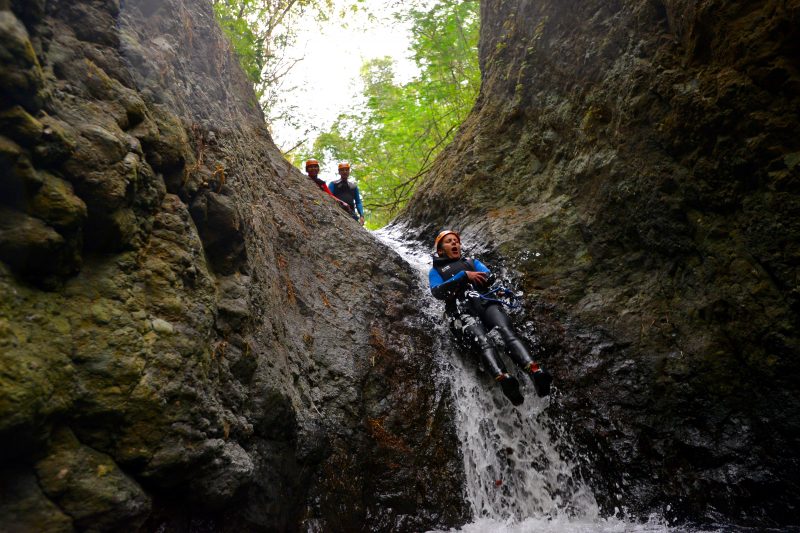
It was no ordinary Sunday morning. My husband and I were deep in the heart of the wilderness, beneath the rainforest canopy of Git Git in northern Bali. We were already suited up in our canyoning necessities: five-millimetre wetsuits, helmets, rubber boots, a climbing harness with carabiners and a Pirana descender for rappelling as well as an unflattering butt cushion for water sliding.
Joined by two other couples, our guide named Angga, his assistant Oka, and Adventure and Spirit’s (Bali’s pioneering canyoning operator) photographer Imin, we explored Kalimudah, the novice’s easy half of the action-packed Kerenkali Canyoning Adventure program. It was a spot in Bali like we’ve never seen before.
Undeterred by the impending rain we trekked down a scenic trail of forested hilltops amidst coffee and clove plantations, clambering over rocks and ridges and sliding down water-polished chutes into surprisingly chilly pools. So far, so good—until Angga started to set up the lines for our first rappel and showed us the ropes (excuse the pun).
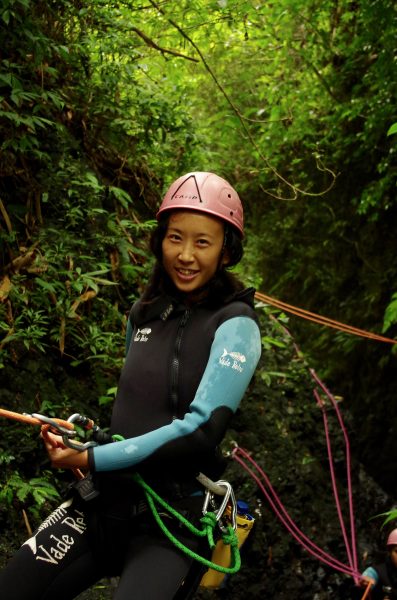 Rappelling or abseiling is the act of descending from a vertical drop in a safe and controlled way by mastering the craft of the knot. The techniques were simple, yet I was nervous. Oka was already at the bottom, holding the (emergency brake) lines, just in case.
Rappelling or abseiling is the act of descending from a vertical drop in a safe and controlled way by mastering the craft of the knot. The techniques were simple, yet I was nervous. Oka was already at the bottom, holding the (emergency brake) lines, just in case.
It was my turn to go. “Lean back and keep your feet flat against the wall,” Angga instructed. I took a deep breath, positioned my hands on the ropes and my legs shoulder width apart at right angles to the rock and descended gradually, a little steadier and faster with each step while maintaining my focus and control.
To my surprise, I did it! I made it down in one piece, albeit with minor scratches. It was a strange sensation: a mix of pride and awe, much like when I took my first underwater breath while scuba diving.
When asked what one should prepare for canyoning, Mika replied, “Bring your courage, smile and trust. The only question you should be asking yourself is: ‘Do you want to do it?’”
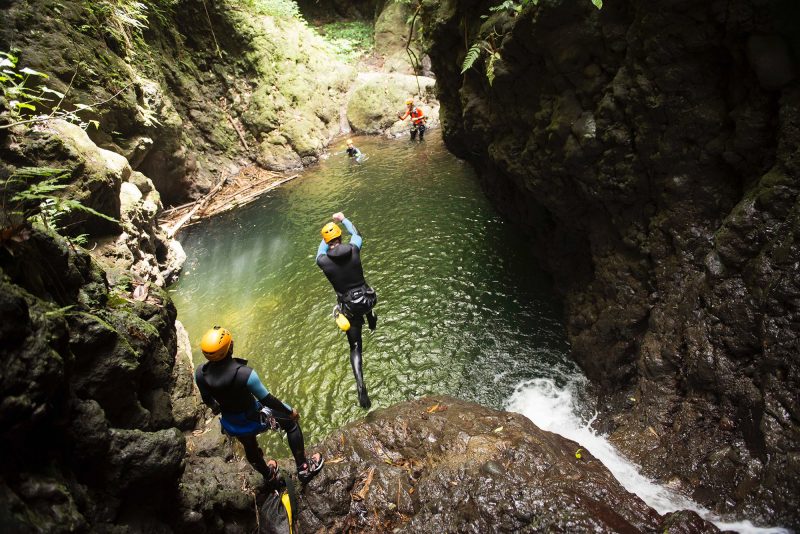
Pumped up with adrenaline and newfound confidence we moved swiftly, completing a cool sequence of jumping, rappelling and zip lining down the volcanic gorges in relative ease.
“Rule number one of cliff jumping: don’t change your mind,” said Angga, a confident, athletic young man with a sparkling personality and an infectious enthusiasm. “Jumping is optional; there is no pressure. But once you’ve decided to jump, stop over-thinking and just do it! The risk is in the hesitation,” he added. He obviously loves his job and is well versed in the art of empathy and the psychology of motivation.
Placing his left foot forward on the edge of the four-metre cliff and his right foot firmly back, he continued, “When you’re ready, push off with your front leg and jump out as far as you can. Before landing in the water, keep your arms in and your knees slightly bent.”
 As if on cue, Oka stepped into the jump position and leapt, striking a cheeky mid-air pose for the camera before plunging feet first into the waterhole. Within seconds he surfaced and signalled ‘OK’ to us. Easy breezy!
As if on cue, Oka stepped into the jump position and leapt, striking a cheeky mid-air pose for the camera before plunging feet first into the waterhole. Within seconds he surfaced and signalled ‘OK’ to us. Easy breezy!
When we arrived at the top of a 15-metre waterfall, our last abseiling challenge before the break, the tropical rain showers had turned into a torrential downpour. Channelling my inner Lara Croft, I braved the waterfall and planted my feet on the slippery rock.
For a minute I was caught off guard by the sheer force of the raging white water pounding me relentlessly. But there was no turning back and absolutely no looking up. My helmet came in handy in protecting my head and providing a breathing pocket under the waterfall as I rappelled down safely.
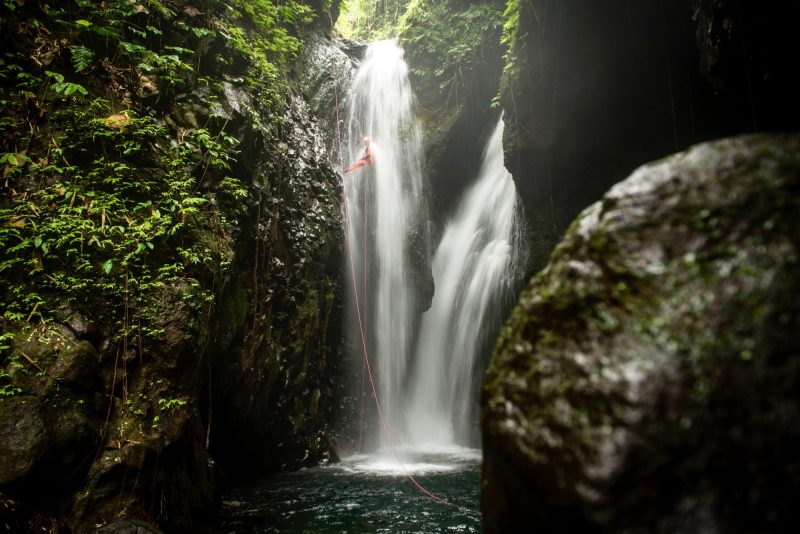 Sadly, due to the prolonged downpour with a possibility of dangerous flash floods, Angga made the unpopular call to end our journey and give Kerenkali a miss, as safety always comes first at Adventure and Spirit. We nursed our wet, disappointed selves with energy bars and sweet tea in a natural hot spring by the waterfall before reluctantly returning to civilization.
Sadly, due to the prolonged downpour with a possibility of dangerous flash floods, Angga made the unpopular call to end our journey and give Kerenkali a miss, as safety always comes first at Adventure and Spirit. We nursed our wet, disappointed selves with energy bars and sweet tea in a natural hot spring by the waterfall before reluctantly returning to civilization.
In 2008, seasoned French canyoneer Michael Denissot (Mika) and his nature-loving Indonesian business partner Robin Endro introduced canyoning to Bali and Indonesia. It took them three years to get the business up and running, and now they are the undisputed experts in leading canyoning tours of all levels into the sublime landscapes of Bali.
 Mika went a step further and initiated the International Canyoning Organization for Professionals (ICOpro) in 2011, which becomes the world’s first organization that offers professional canyoning training, standardization and certification.
Mika went a step further and initiated the International Canyoning Organization for Professionals (ICOpro) in 2011, which becomes the world’s first organization that offers professional canyoning training, standardization and certification.
When asked what one should prepare for canyoning, Mika replied, “Bring your courage, smile and trust. The only question you should be asking yourself is: ‘Do you want to do it?’” One will never know one’s powers until one unlocks the fear. “When our guests arrive at the end of the waterfall, many of them feel like they have won something,” shared Robin. “They have conquered their fear,” he smiled.
And so have I. I went home from canyoning feeling enriched, humbled and exhilarated. This experience has extended my physical and mental limits, inspired my spirited sense of adventure and deepened my respect for nature, especially the personal nature of my heart, mind and body.
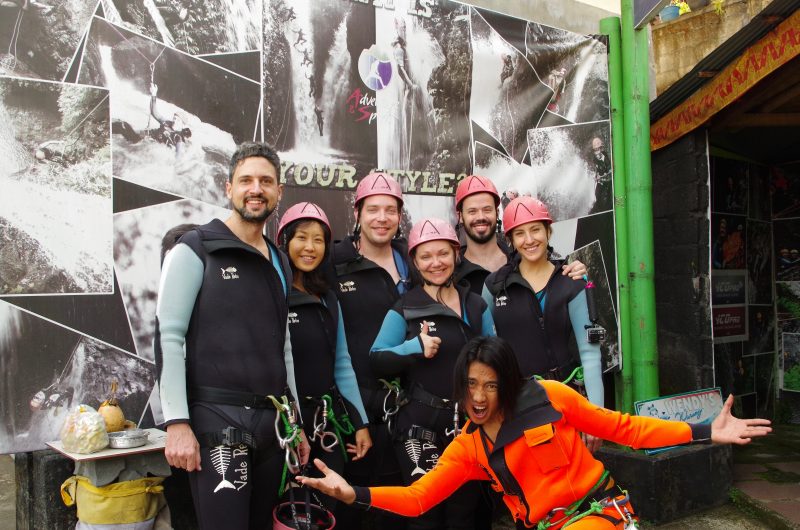 In a team extreme sports environment such as canyoning, we cannot help but bare our souls for others to see. Angga said it best, “In nature, we are a team. There is no boss or customer. We support and help each other along the way. We are equals.” And that’s the spirit in canyoning… and in life!
In a team extreme sports environment such as canyoning, we cannot help but bare our souls for others to see. Angga said it best, “In nature, we are a team. There is no boss or customer. We support and help each other along the way. We are equals.” And that’s the spirit in canyoning… and in life!
PT. Adventure and Spirit
Mas, Ubud, Bali
Tel: +62 361 971 288
www.adventureandspirit.com
Notes:
This article was first published in Bali & Beyond — November 2016.
Photos and videos courtesy of Adventure & Spirit.

